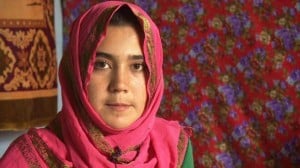Just when I thought we were past discussing the experiences of Muslim women in dichotomies and distorted imagery, CNN pulls out this gem about Afghanistan’s most talked-about talk show: “Niqab.” “The Mask,” as American media have translated it, features “Afghan women [who] dare to speak out on [the] taboo subject of abuse by husbands.” This time, the women televised are, in fact, masked—half the mask “pale blue, the color [of the burqa] symbolizing the oppression of women; the other half white, representing innocence.” As though this simplistic, dichotomous analysis (which, incidentally, removes all agency from the show’s women) isn’t enough, CNN goes on to write that these women, heretofore silenced (multiple meanings, of course) and concealed (ditto) are “speaking out” at long last, their stories of abuse and torture spilling from loosed-and-liberated lips.
I dramatize, of course, to underscore the absurdity of the reporting. The article, like its contemporaries, toes the line between objecting to the rape and abuse of women and objecting to the customs surrounding marriage more generally. And while the latter is by no stretch ideal, it’s certainly very different from the former, and deserves a more nuanced look than it’s being given here.
But the stories are true and real, and though CNN pulls only snippets of their tragedy and sets them against the standard backdrop of this-is-the-struggle-of-Afghanistan-today-and-forever, “Niqab” features them prominently every segment. There’s the story of Yasmin, who was 13 when her family married her off for $1,000. She was beaten and tortured by her in-laws. There’s the story of Saraya, who was married to a 58-year-old man with a rape record when she was just 15. As they and other women tell their stories on air, a studio audience of human rights experts and lawyers legitimizes the conversation by assuring Afghan viewers that the abuse is neither legal nor Islamic.
The businessman behind the television catharsis is 28-year-old Sami Mahdi. He’s young, he’s good-looking, and he’s scooping up women from shelters and refugee camps and plopping them in front of a camera, albeit masked. As the National Post reports, Mahdi is ready to shake things up in Afghanistan: he hopes to launch other live shows at his station, 1TV, with topics such as “Should the country decentralize its government?” and “Does Afghanistan need the international forces and coalition to stay beyond 2014?”
While the idea of bringing serious dialogue to Afghanistan via talk show is certainly refreshing, “Niqab” is different. Mahdi himself admits that even when he wasn’t sure of the concept of the show, he was “very sure of the mask.” (I’m not sure whether that means that he saw the need for its protective anonymity, or whether it was perhaps metaphorically relevant). Mahdi claims that while he’s not sure his program can change the lives of the women behind the masks, he hopes it will change the lives of other women by changing the minds of Afghan men. He plainly acknowledges that the women on air are victims, and likely always will be.
There seems, inevitably, something exploitative about “Niqab.” I say that with some hesitation, though, because it’s nevertheless ground-breaking television in Afghanistan. Still, there isn’t enough of an orientation toward action—at least, not enough of that orientation to justify the slightly disturbing components of the talk show. First, there’s Mahdi himself, who’s center-stage in the American media discussing his idea to spotlight abused women and “giving them a voice.” Except that he’s a man, utterly removed from (and yet the only real face of) his female guests’ horrors. The women behind their masks are scared and upset, and the audience is scared and upset, but that’s about it. Everyone is scared and upset for women and their status in Afghanistan—and perhaps that’s because none of the stories are focused on survival, or on finding help, or even providing resources.
The idea, as far as CNN and other outlets have reported—and as far as Mahdi himself has said—is to precipitate an emotional catharsis on camera and hope that it makes some men think about their actions. But with Mahdi’s increased access to NGOs, shelters, the human rights commission and the ministry of women’s affairs, he has a unique opportunity to use his reality-show stage more productively, sparking debate and distinguishing survivors from victims, empowerment from defeat.














